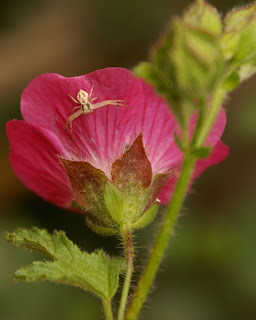
Crab spiders of the family Thomisidae lay in wait on flowers for their insect prey. They are usually hard to notice because they are colored to match their flowery surroundings, and also they have markings that seem to help disguise make them look like part of their flower. Since insect eyesight responds to different wavelengths of light than our human eyes do (notably, ultraviolet) it might be a bit presumptious to conclude that the crabs are as well hidden from, say, a bee's sight as they are from ours. I read a study that found that bees were actually attracted to certain flowers that were inhabited by crab spider, having something to do with the spiders' mimicry of the ultraviolet markings in the center of the daisy flower under study. So, it seems there are multiple strategies of hiding in crab spiders' repertoire.
Anyway, these two young crab spiders have each staked
 out a flower from the Mallow family, or the Hibiscus family if you prefer, for their hunting grounds. As you can see, the spider on the yellow/gold abutilon palmeri is not gold, and the spider on the pink anisodontea is not crypticly (at least to the human eye) pink yet. Crab spiders adjust their color to blend into their habitat, but how this happens is still a mystery to me.
out a flower from the Mallow family, or the Hibiscus family if you prefer, for their hunting grounds. As you can see, the spider on the yellow/gold abutilon palmeri is not gold, and the spider on the pink anisodontea is not crypticly (at least to the human eye) pink yet. Crab spiders adjust their color to blend into their habitat, but how this happens is still a mystery to me.
1 comment:
How they change colors? They pump small pigments being inside their skin to the upper regions of it so it can be seen. So if they find home on a yellow flower, they begin to pump yellow pigments upwards. The other direction is harder and slower: once a yellow spider wants to become white again, it has to solve the pigments chemically, it has to make the enzimes, then the enzimes must solve the pigments, and it is less easy and less quick than simple physical work of pumping the proper pigments.
Post a Comment